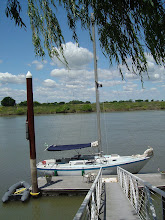
Engine Overhaul
One of the big, important tasks on the plate early on was to get the venerable old Atomic 4 running again. Budget considerations precluded any sort of fancy new diesel engine, so resurrect the Anemic 4 it was!
I had already figured out that there wasn't a useful amount of fuel making it to the combustion chamber, no spark, and no compression in any of the four cylinders. Sweet. I pulled the head and found that all four exhaust valves were stuck (read: rusted) in the open position. I also found a rather disturbing amount of water in the Nº 4 cylinder, as well as a small amount in Nº 3. Once I got into the exhaust section I noticed that the water mixing elbow - which, in normal circumstances, should direct the flow of cooling water down the exhaust pipe into the muffler - was actually on the manifold side. Great. At least I knew why it stopped running in the first place.
So, six months and a whole mess of Pb-Blaster and Marvel Mystery Oil later - not to mention some judicious hammering - the exhaust valves were once again free. The inlet valves weren't too bad to begin with and came out with only minor coaxing. I took the head down to my local machine shop and had the surface milled and had it primed for painting. The block got as much of a work-over as I could give it without actually removing it from the boat. There was a heavy amount of scaling on the water jacket side of the motor, which was taken care of by some of West Marine's "Rust Lock Metal Prep", a sort of purple liquid which converts iron oxide to iron something else, and allowed it to be scraped off, primed and painted. Normally this stuff turns the rusty areas a deep black, but in the case of the Atomic 4 it ended up turning all the rust into a white powder. My guess is that due to the fact that the Atomic 4 was cast in some sort of unique alloy that was supposed to be resistant to corrosion. Given that the motor sat a sailboat that was primarily in salt water for 40 years I think it was doing okay. With a fresh coat of primer and paint, it should be good to go for another 40 years.
Now for the fun part... Putting it all back together.
I became a fan of
Moyer Marine, the east coast operation that deals specifically with Atomic 4s. They have a number of parts for sale that are otherwise relatively unobtainable. So, I got a new water jacket side plate, with new and improved water directing technology, new valve cover, water pump overhaul kit (which included a new shaft, impeller and cam), as well as the extend-o-bolt to allow easier maintenance of the pump, new stiffer valve springs, and a carburetor overhaul kit. Oh, and a new oil vent cap. Oh, and a new thermostat and thermostat housing. From West Marine I got all new water hoses, raw water strainer, fuel water separator (the beefy one!), and various fittings to make a rig for flushing the engine from a bucket or dock pressure.
I rebuilt the carburetor with all the spiffy new parts from Moyer, hooked up the fuel and water lines with their respective new goodies, put the (original!) valves back in with the new springs, closed 'er all up and crossed my fingers.
After some fiddling, she fired up! Man, what a fun day that was! Six months, about $1000, lots of cursing, as many bloody knuckles and a few beers was all it took!
Check out the shots
here. (unfortunately my camera died around the time that I finished this project so there is no 'after' shot yet)
Here is a list form of the work done to the engine:
• Ignition Coil Replaced
• Plugs/Wires replaced
• Points replaced
• Carb rebuilt
• Thermostat/housing replaced
• all Brass Fittings replaced
• H20 Pump rebulit (new cam, seals, impeller, cam, 'easy' fastener)
• Hoses replaced
• Exhaust mixing elbow replaced
• Head Magna-fluxed, surface milled,
• Valves removed, cleaned, seats lapped, reused
• Valve springs replaced with stiffer springs
• Raw H2O Strainer
• H2O jacket side plate replaced
• new Diverted flow "t" inlet
• Fuel/Water Seperator replaced
• Fuel Shutoff valve installed
• Cleaned, Primed, Painted,
• Oil Changed












